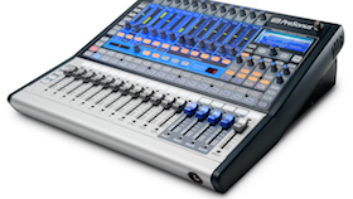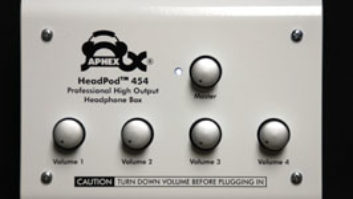Twenty-five years ago, an IBM PC with its 64k RAM and 4.77MHz speed would have set you back $6,000. Today, that same price could buy a very nice setup, with gigs of RAM, terabytes of storage, monitors that stretch as far as the eye can see and blazingly fast CPUs. We’re in a cost-down/power-up market, driven by the latest Intel Pentium 4s and AMD Opterons for your PC or Intel’s Core Duo chipsets pumping the latest “MacTel” generation from Apple. Meanwhile, these super-CPUs, along with native processing and FireWire peripherals, have opened up the door for the serious laptop studio. In terms of computer-based DAWS, these are the good old days.
Keeping up with the demands for more speed, power and features, computer-based DAWs are evolving at a dizzying pace. Meanwhile, the number of players in the industry has actually increased. For example, several systems that were once loop player/editors — such as Apple’s Soundtrack Pro or Sony’s ACID — have become full-fledged DAWs. Many DAWs have expanded their feature sets with more built-in DSP effects (or included plug-ins), virtual instruments and more, coming closer to a one-stop production solution. So, with a whole lot going on, we checked in with computer-based DAW companies to keep up with the latest developments.
Apple Logic Pro 7.2 runs natively on both PowerPCs and Intel-based Macs.
Combining MIDI sequencing, looping, VIs, effects and 32-bit/192kHz multitrack hard disk recording in an interface designed for fast, real-time music creation is Ableton (www.ableton.com) Live. Live 5.2 brings native support for Apple’s new Intel-Macs for significant gains in track count, instruments and effects for a nominal $49 upgrade, while still supporting Windows and non-Intel Macs. Ableton has announced Live 6 (due Q3 2006), which will support multicore/multiprocessor architectures to the benefit of both Windows and Mac OS users.
Available this month, Apple‘s (www.apple.com) flagship Logic Pro 7.2 runs natively on both PowerPC and Intel-based Macs. Among 7.2’s features are support for Apogee’s Ensemble FireWire I/O interface, compatibility with Pro Tools|HD 7 DAE and the ability to directly open GarageBand 3 projects. Among its feature set is stereo Rewire object support, control surface support enhancements (including support for M-Audio’s iControl GarageBand controller), 32-channel support for multichannel Audio Units instruments and the ability to play AAC and Apple Lossless compressed files.
BIAS Peak Pro 5 can be used as a 2-track recording/mastering tool or as a flexible editing solution for an existing workstation.
It started off as a quick means to create production music from loops and has become a full-on recording DAW, with multichannel editing and more than 50 integrated AudioUnits and Logic plug-ins. SoundTrack Pro seamlessly integrates with Apple’s Final Cut Pro 5, with several useful apps for dealing with noise, glitches and pops. SoundTrack Pro is now only offered as part of the $1,299 Final Cut Studio suite; however, STP owners can upgrade to the entire Final Cut Studio bundle (including STP, Final Cut Pro 5, DVD Studio Pro 4 and Motion 2) for a bargain $199. Shipping later this month will be Universal (Intel/PowerPC-based Mac-compatible) versions of Final Cut Studio, with a low-cost “crossgrade” available to current owners.
Whether used as a dedicated 2-track recording/mastering tool or as a flexible editing solution for an existing workstation, Peak Pro 5 from BIAS (www.bias-inc.com) offers sample rate conversion, batch processing, Red Book CD burning, advanced editing, looping, DSP, plug-ins and more. This Mac OS X app is available in several forms: the $599 Peak Pro 5 or the $1,199 Peak Pro XT 5, which includes Peak Pro 5, SoundSoap 2, SoundSoap Pro and the new BIAS Master Perfection Suite. Also sold separately at $599, BIAS MPS is a bundle of six pro plug-ins (Pitchcraft, Reveal, SuperFreq, Repli-Q, Sqweez-3/5 and GateEx) for AudioUnits, DirectX, RTAS and VST host apps.
Cakewalk (www.cakewalk.com) announces SONAR Power Studio™ 250 and 660 — two bundles that combine hardware interfaces with the SONAR Studio Edition, taking advantage of the power of 32-bit and x64-compatible PCs. Shipping next month, the $599 Power Studio 660 includes Cakewalk’s SPS-66 24-bit/192kHz FireWire interface; the $449 Power Studio 250 comes with the SPS-25 24-bit/96kHz USB interface. Both packages ship with Roland GrooveSynth™, TTS-1 GM 2 synth, Cyclone™ groove sampler and SFZ Soundfont player; the Sonitus: fx effects suite; and Lexicon’s Pantheon LE reverb. Also included are Roland’s V-Vocal VariPhrase pitch/harmony technology and IK Multimedia’s Amplitube LE.
Cakewalk SONAR takes advantage of 32-bit and x64-compatible PCs.
Digidesign‘s (www.digidesign.com) Pro Tools 7 has Windows XP and Mac OS X versions for Pro Tools|HD, LE and M-Powered systems. Features include all-new Instrument Tracks for improved integration with virtual instruments and MIDI sound modules, new real-time MIDI processing, REX and ACID file support, host processing optimization for running more instances of RTAS processing/instrument plug-ins and a streamlined, re-organized menu structure. The big software news comes from Pro Tools 7’s completely overhauled RTAS engine, now allowing up to twice the number of RTAS plug — ins as compared to using Pro Tools 6.9.2 software on dual-processor CPUs. On the hardware side, Digidesign now offers both PCI and PCI Express (PCIe) versions of its hardware cards to ensure Pro Tools|HD compatibility with PCIe-based Mac G5s.
Digidesign’s $1,295 DV Toolkit™ 2 for Pro Tools LE offers a toolset for producing sound for film or video, including the TL Space™ Native Edition convolution reverb, DINR™ LE noise reduction and Synchro Arts’ VocALign Project time-alignment plug-ins. Also provided are tools for importing/exporting projects to/from video editing apps and MP3 export. DV Toolkit 2 can expand LE sessions to up to 48 mono or 48 stereo tracks at up to 96 kHz, and adds many post-specific functions, such as working in timecode and Feet + Frames, a Scrub Trim tool, continuous scrolling, Replace Region and Edit to Timeline Selection commands and more.
To expand the power of Pro Tools LE or Pro Tools M-Powered systems, the company’s Music Production Toolkit ($495) offers new plug-ins, enhanced editing tools, MP3 file export and increased system track count to 48 mono or stereo 96kHz tracks. Included plug-ins are the Hybrid high-definition synth, TL Space Native Edition convolution reverb; Smack!™ LE compressor/limiter; SoundReplacer and DINR LE noise reduction. Music Production Toolkit also has a multitrack version of the Beat Detective automatic groove analysis/correction tool.
Digidesign Pro Tools 7 has Windows XP and Mac OS X versions for Pro Tools|HD, LE and M-Powered systems.
M-Audio‘s (www.m-audio.com) Pro Tools M-Powered is a cross-platform (Mac/PC) version of Pro Tools that runs on select M-Audio hardware. The software is similar to the familiar Pro Tools LE, but lacks certain features such as SMPTE timecode support. However, the package includes 30 plug-ins, adds Digidesign Command|8 controller support and allows sessions created on the software to be imported directly into Pro Tools TDM and LE systems, making it ideal for inter-studio collaborations. A new enhancement is Digidesign’s Music Production Toolkit (described above), which expands the capabilities of M-Powered systems.
Mackie‘s (www.mackie.com) Tracktion 2.1 64-bit — capable PC/Mac recording software enhancements include direct MP3 file import/export, simultaneous multiple files import, file import from a PC’s CD drive and the ability to create MIDI (and audio) loops as clips. Controller support is increased, now including Frontier’s TranzPort, in addition to a custom function for tweaking Tracktion’s transport, navigation, options and channels for use with most hardware/keyboard controllers. Mackie is also offering six new free plug-ins (reverb, compressors, EQs and stereo panner) to registered Tracktion 2 boxed bundle owners.
Magix (www.synthax.com) is shipping Samplitude V. 8.2 multitrack record/mix/sequencing software for Windows XP. New features include a MIDI drum and controller editor; Vintage Effects Suite PRO (with chorus/flanger, delay and filter plug-ins); VST Waves shell support; tempo maps for VSTi, ReWire and VST effects; and a Sound Cloner feature. Surround enhancements include 5.1 panning, multichannel EQ, dynamics and a convolution-based, real-time room simulator.
Sequoia is Magix’ high-end, multi-user, network-capable DAW software for native host PCs. Version 8.2 shares most of the updates offered in Samplitude 8.2 (listed above), but goes deeper with more pro functions, such as support for all major multichannel formats (freely configurable up to 12 channels), a full-function 48-track mixer, Magix Elastic Audio (audio pitch shift — editing, auto-pitch correction and pitch automation algorithms), the Robota Pro 8-voice virtual analog synthesizer with integrated step sequencer, DVD-Audio stereo and surround disk burning, extended support for external hardware controllers and full-screen video output with 16:9 support.
Version 5 of Merging Technologies’ (www.merging.com) software-only version of its full-blown 128 I/O Pyramix Virtual Studio DAW provides a major increase in functionality. Pyramix Native now has a maximum of eight I/Os with full 24-track editing and doesn’t require Merging’s Mykerinos DSP hardware. It retains all of the editing/mixing capabilities of the main Pyramix VS system with real-time factory plug-ins for EQ, dynamics, metering, etc. A range of third-party plug-ins is also available, including reverb, audio restoration and time compress/expand with DirectX and VST compatibility. Pyramix Native can operate on any Windows XP — based desktop or laptop using the computer’s onboard audio engine or ASIO-compatible audio card.
Digital Performer 5 from MOTU (www.motu.com) is a major upgrade that includes six new virtual instrument plug-ins, track folders, a meter bridge feature, new audio editing tools, numerous film scoring features, new input monitoring modes, clip-based volume automation and more. Instruments in this Mac OS X DAW include BassLine™, a monophonic bass synth; PolySynth™, an analog-style synth; Modulo™ subtractive synthesis; Nanosynth™ (sampler, plus filter mods); Model 12™ drum module; and Proton™, a two-operator FM synth. For film/TV composers, Digital Performer 5 can now superimpose streamers, punches and flutters directly on a QuickTime movie playing in Digital Performer’s movie window for easier collaboration with music editors and prepping for soundstage scoring sessions. Version 5 also supports CueLine ProCue 1m1 and ClickStreamMachine, two third-party devices for live orchestral scoring. DP5 ships Q1, 2006, for $795.
RML Labs has released V. 3.9k of its SAWStudio/SAWStudioLite PC-based mixing/editing DAW. Recent enhancements include a Hot Track Solo mode, the ability to host VST plug-ins in any folder on any drive, a function for automatically compensating for the latency of VST plug-ins and a bypass of the auto-compensation feature. The company has also started an improved online SAWStudio User Group that lets users chat with SAWStudio developer Bob Lentini and longtime SAW users at www.sawstudio.com.
SADiE (www.sadie.com) is shipping V. 5.4.1 software for its Series 5 range of PC-based DAWs. Features include new automation snapshot facilities; multitrack and group editing in the Trim window; multitrack editing in Playlist Edit; CD ripping interface (with automatic sample rate conversion where required); a Dither window; and support for Mackie HUI and Yamaha DM2000. Options include multichannel CEDAR plug-ins, VST plug-in support, CD-text support, auto-conforming, enhanced 9-pin control for up to 64-channel record enable, Pro Tools 5 interchange and more.
Slated for release at AES Paris, soundBlade ($1,495) from Sonic Studio (www.son icstudio.com) is a host-based, OS X — native application, offering stereo record/editing, integrated CD burning and PQ handling. Its source/destination editing model and cut/copy/paste editing with improved Fade tool simplifies editing chores. Other features include optional support for Sonic’s Model 302 DSP hardware; drag-and-drop files from iTunes or any .AIFF, .WAV, Broadcast .WAV or SD2 source; high-quality sample rate conversion; psychoacoustically optimized shaped triangular redithering; and VST and AudioUnits plug-in support.
Shipping this month is Sony‘s (www.sonymediasoftware.com) ACID Pro 6 ($499.95), a major upgrade that takes this native Windows 2000/XP loop-based music creator to a new level with full-featured, 24-bit/192kHz audio support and new MIDI editing and workflow capabilities. New features include unlimited audio and MIDI tracks with on-the-fly punch-in overdubbing; VSTi parameter automation; drum map editing; Mackie Control Universal support; real-time pitch and tempo matching; more than 20 real-time DirectX effects; 5.1 mixing; and more.
Now at V. 8, Sony’s Sound Forge native PC recording/editor platform adds new features such as VST plug-in effect support, ASIO driver support, batch conversion, Flash-format (.swf) import, direct export to CD Architect software, an Audio Scrubbing tool, customizable keyboard mapping, and additional HD video options, including support for 24fps DV video files. Sound Forge 8 also includes a full version of CD Architect 5.2 software for disc-at-once CD burning.
Having purchased the company back from Mackie, Soundscape (www.sydec.be) has opened a U.S. office in Florida. Highlights in Editor V. 5 include the ability to play/record native (PC-based) tracks; the software is offered as an update to all Soundscape 32 and REd users. Also new is a full line of 24-bit/96kHz interfaces supporting 24 to 64 simultaneous I/O channels in various formats — analog, TDIF, ADAT, AES and/or MADI — along with two new hardware controllers and a remote 8-channel mic preamp.
Steinberg‘s (www.steinberg.de) Cubase SX3 adds some 70 features, including Audio Warp Real-Time Time-Stretching, in-place editing of MIDI to audio and/or video events, and many new editing functions. Beyond its included VIs, audio mixing and loop/pattern-based arranging, this native OS X and Windows XP DAW also adds MIDI device maps with user-definable graphic editing panels, Studio Connections “Total Recall” support (optional integration of Yamaha’s Studio Manager 2), external effects plug-ins for integrating external hardware effects processors into the VST audio mixer and more.
Steinberg’s flagship Nuendo 3.2 DAW software includes a unique control room busing/monitoring system, allowing separate mixes to be created for headphones, control room and up to four studios, along with foldback, external audio source handling and up to four separate studio mixes with integrated talkback. Control surface integration is also expanded with all of 3.2’s control functions now available in the WK Audio ID Controller, a Nuendo control surface co-engineered by Steinberg. Nuendo 3.2 also enhances support for the Euphonix MC and System-5 MC control surfaces.
An all-in-one solution for high-res stereo/multichannel audio editing, mastering, CD/DVD burning and CD or DVD-Audio production, WaveLab 6 ($699) adds more than 120 new features, including the new Spectrum Editor, full integration of outboard effects and hardware remote controllers, a loudness-corrected SmartBypass system, DIRAC time stretch and pitch-shift technology, Bob Katz’ K-System metering and more.
George Petersen is Mix’s editorial director.
THE HARDWARE ALTERNATIVE
While this article focuses on computer-based DAWs, hardware-based systems offer a straightforward solution where manufacturers can tailor a system to specific chores. At one end of the hardware spectrum, just about every soundcard, hardware or I/O manufacturer on the planet (E-mu, Lexicon, Focusrite, M-Audio and Metric Halo, among many others) ships product with a “lite” or freeware offering, although these are not covered here.
The DAW-in-a-box designs — such as those from Alesis, Genex, iZ/RADAR, Mackie and Tascam — have also found favor as multitrack replacements in applications where users already have a favorite console to work on, as well as a convenient means to move tracks around from studio to studio (or dub stage) or patched into a live board for remote recordings. Interestingly, while these were born as hardware-only solutions, all have expanded the feature sets immeasurably via external control software. On a larger scale, DAWs such as AMS-Neve’s AudioFile and Fairlight’s DREAM Series are equally suited to stand-alone use or integrated into consoles, creating a seamless production environment.
Smaller all-in-one products, such as the offerings from Roland, Korg and Yamaha (with their record/mix/master/burn functionality), have maintained a solid niche in both small project rooms and pro apps such as radio spot production.
— George Petersen
WHAT’S IN A NAME
Ramping Up Your DAW With 64-Bit Processing and PCI Express
Our vote for the hottest buzzwords of 2005 goes to “64-bit processing” and “PCI Express (PCIe).” However, these latest developments in computer power and interconnectivity aren’t just paying lip service; they deliver all they promise and more. On the Mac side, PCIe architecture was first introduced in the December 2005 Power Mac G5 carrying twin Dual-Core processors operating at up to 2.5 GHz per core. The new digital pathway betters the previous G5 PCI standard by offering three slots, providing a series of “lanes” (two four-lane slots and one 8-lane slot) that allows data to travel over a series of discrete two-way, point-to-point paths rather than sharing a single path as before. This offers some serious horsepower to Mac users, specifically in relation to Pro Tools when coupled with the PCIe cards that Digidesign released concurrently with the new Apple computers. For instance, HD1 users will gain the ability to run some Accel plug-ins, despite the absence of an Accel card, and see up to an 80-percent increase in power. HD2 users will see a 20-percent performance boost, and the HD3 user will see no significant change.
On the PC side, users can avail themselves of the latest 64-bit technology, but what’s the advantage? For starters, x64 CPU architecture gives the user the ability to carry more RAM than is possible with a 32-bit system. Most importantly, the extended memory cache lets users run more RAM-hungry software instruments. At the recent Winter NAMM show, Cakewalk demoed a project running on a 64-bit system that ran 125 tracks, including 16 instances of its Dimension Pro sampler — a session that wouldn’t even load on a 32-bit system. The main components needed to supercharge your system is a computer with an x64 processor, a 64-bit operating system — such as Microsoft’s XP 64-bit edition — and drivers for all of your hardware. What’s the downside? You can’t run your 32-bit plug-ins on the new systems. However, Cakewalk now offers Bit Bridge in SONAR 5, a workaround that allows you to host 32-bit plug-ins on a 64-bit system.
— Kevin Becka
Still trying to figure out what to get? Check out these articles on products and applications from past Mix issues:
Choosing a Digital Audio Workstation
The Console-Workstation Interface




